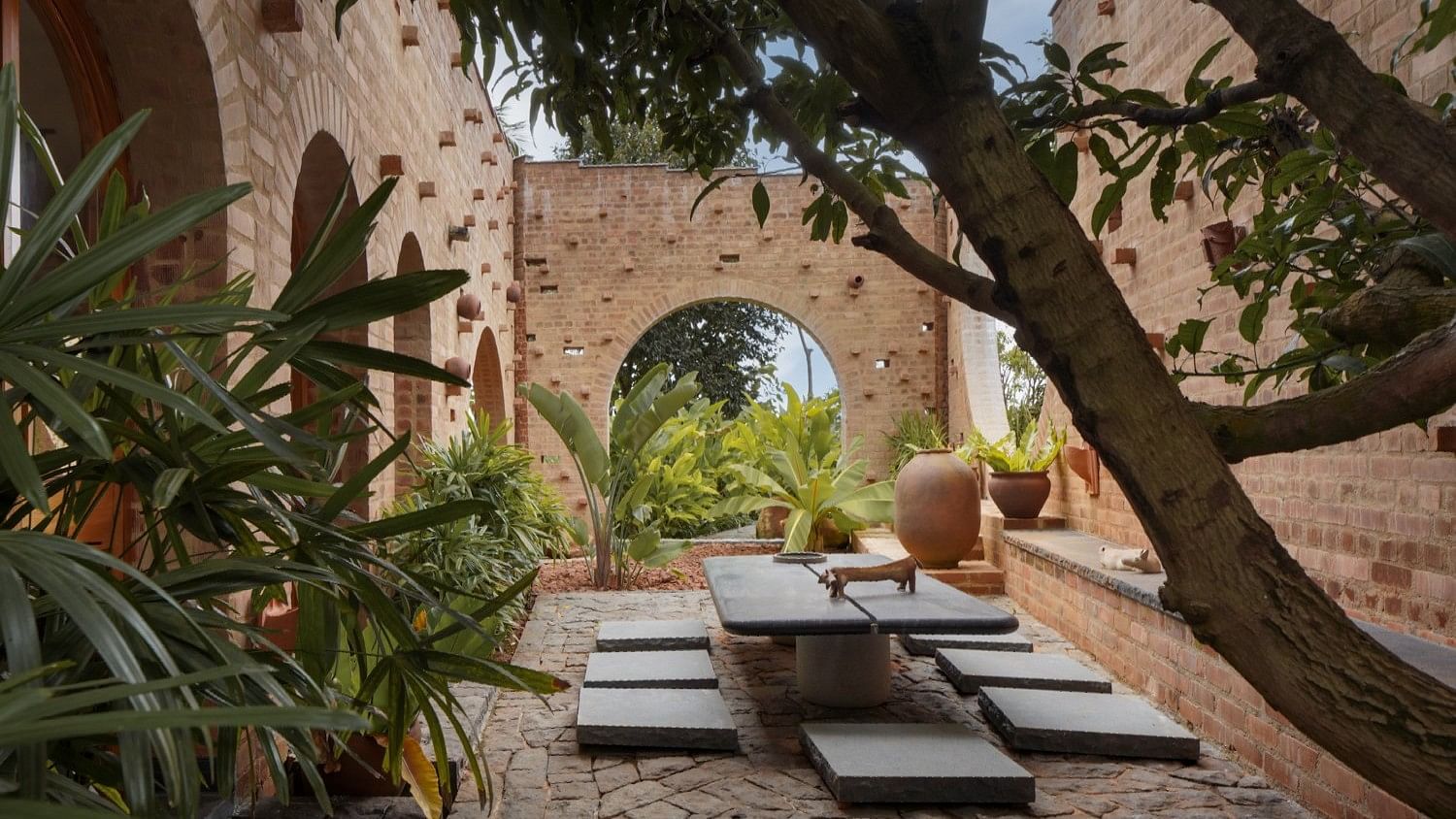
By arrangement
New homeowners are embracing the exposed brick aesthetic. Here, brick, concrete, stone, and untreated wood are left uncovered, free of paint or plaster. The aim is to achieve an unfinished look but one that also adds warmth and a rustic charm to the space.
Experts share tips and tricks to get the look right.
Lot like outdoors
Amit Khanna, design principal and founder of New Delhi–based Amit Khanna Design Associates, turns the spotlight on his latest home project. The task was to add an outdoorsy vibe to the staircase leading from the house to the terrace — like one is already out in nature.
They built floating steps out of Kota stone. The staircase juts out of a wall of rough Delhi quartzite, while yellow Jaisalmer stone is used for the stairway leading to the steps as well as the adjacent courtyard wall. The adjoining wall was made of raw red bricks. The team carved a cosy seating under the stairs, again from Kota stone.
Working on an exposed aesthetic requires meticulous planning and precision. “You have to get the electrical and plumbing right from the start because once the walls are up, there’s no hiding mistakes. With no plaster or paint to cover anything, it’s all about nailing it the first time,” says Khanna. In this project, his team installed staircase lights while the walls were still being constructed. This allows for precise placement of the electrical work and reduces the room for error, he emphasises.
Cave in
Avinash Ankalg is the co-founder of Bengaluru-based design studio A Threshold. He worked on a home project in Kaggalipura and lent a cave-like vibe to the bedroom. He left the stone flooring unpolished, allowing it to absorb light in a way that it exudes an organic, earthy feel. To keep the look unrefined, he opted for locally sourced bricks with a rough texture and exposed concrete. “None of the surfaces are plastered,” Ankalg says. This is his way of staying connected with nature and living inside “a modern cave”.
To complete the cave look, Ankalg added a big arch at the entrance of the room, doing away with conventional doors and windows. It not only provided structural support but also aligned with the project’s theme of a subterranean dream.
The interiors were kept minimal. It boasts local jungle wood furniture (think teak and other hardwoods) and vintage-style rotary switches and exposed electrical conduits. They planned a dining space outdoors. “We have gone with a Japanese-inspired floor seating and used local granite and Kadapa stone. The existing mango tree acts as a natural canopy,” he adds.
Go local
“We grab red stones right from the site and mix them with local mud to make mortar,” says Harshith Nayak, co-founder of Ankalg’s firm. This not only cuts down on the carbon footprint but also blends the building with its surroundings. As these exposed materials age, they develop a unique character over time, he adds.
Unique touch
Sushmi S is the principal architect and founder of Alora Designs in Bengaluru. She shares details about her latest project in Bengaluru. The main structure’s interior is built using Porotherm blocks (lightweight bricks) with brick cladding that is seen from outside. Inside, you’ll see exposed Porotherm blocks making a statement on accent walls behind beds. Balancing the need for raw aesthetics and thermal insulation is often tricky and in this case, Sushmi avoided placing the electrical conduits. To keep things visually interesting, she added natural boulders, and a circular brick opening that serves as a skylight for the space.
Keep it cohesive
Nilay Patalia, founder of Nilay Patalia Architects in Bengaluru, speaks about a unique home he designed near Turahalli Forest. The team had to build the house around 40 trees. They integrated openings in the design to allow for the trees to keep growing.
It also stands out for its eco-friendly approach and raw aesthetic. Granite slabs that would have been otherwise discarded were recycled and used as stone walls. The reddish interior walls make use of local materials like sand, cement, and mud.
Patalia describes how he achieved a cohesive look: “We kept the concrete ceiling visible to highlight the raw materials. We crafted the doors from solid pine wood. The flooring combines wood, Athangudi tiles, Kota stone, and cement.”
Clever choices
Rammed earth and load-bearing walls embody a rugged aesthetic. These materials are popular choices to build spaces with unrefined looks, without the need for paint or plaster.
The load-bearing stone and rammed earth need to be assembled to form thick walls so they can support the weight of the building. They must also not be spaced too far apart, Thus, the size of windows and doors will need to be altered accordingly.
Thus, designers must carefully plan the size and layout of rooms. Large openings will weaken the walls, so extra support like columns are necessary.
In one of Patalia’s projects, the column shapes were designed to complement the space. Circular columns were used in the round front deck, while square columns were used to go with the rectangular design of the back deck.
Wallet factor
Experts say this approach makes use of unique materials and that’s why such homes would be about 10% costlier than the standard. However, you save up on the plastering and paint charges. Set aside Rs 3,000 to Rs 5,000 per sq ft.